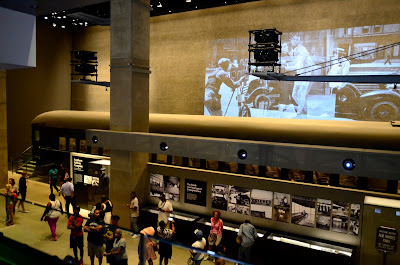The museum was designed by David Adjaye with Philip Freelon the lead architect. It is three tiers of inverted half-pyramids. The exterior pattern of the bronze-hued screen is based upon ironwork created by freed slaves in New Orleans and Charleston.
Jackie and her family with us.
The museum presents an in depth history of slavery not from the viewpoint of historians but from that of those who lived and struggled during the centuries of slavery and of those who contributed to the construction and culture of our country. Many of the artifacts on display were contributed or loaned by individuals throughout our country.
We started on the lowest floor where we learned of the thriving communities in Africa and of the early trade between African nations and European nations. That trade went from produce to people and led to slavery in America.
Queen Nzingha of Ndougo, Kongo traded with European nations in order to fight off the Portuguese efforts to increase slave trade and control central Africa..
Displays told of the conditions of slavery and of the many uprisings that tried to end it. Personal comments by slaves, slave-owners and those involved in the slave trade are posted throughout the exhibit. One prominent man said he opposed slavery but knew he could not live without his sugar and rum.
A few African Americans gained the freedom. This is the one room home of a freeman.
While this auction block symbolizes slavery
this scarf given to Harriet Tubman by Queen Victoria symbolizes freedom.
The Civil Rights era is shown in both protest and culture. Exhibits of George Wallace stand near those of the first television shows featuring African American performers. A segregated rail car is not yet open for viewing.
An actual aircraft used for training of the Tuskegee airmen during WWII still flies above the crowd.We all enjoyed lunch from the highly-rated museum cafeteria. This is large museum with a long and important story to tell that cannot be seen in one visit. We all need to return later to see exhibits on this continuing story.








No comments:
Post a Comment